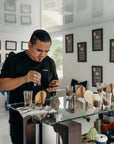The Caturra Chiroso variety reportedly developed from genetic mutations in the high-altitude mountains of Antioquia, Colombia. It was a mutation that permitted this variety to thrive amid atypically colder temperatures and low light intensity, which spur the increased development of multiple compounds in the coffee cherries, such as monoterpenes known to generate more pronounced flavor profiles.
Finca El Paraiso and INDESTEC's ingenuity lies in having thoroughly studied, implemented, and documented their simultaneously structured and creative processing methods and techniques at such a high level of granularity that allows for consistent repeatability of their approaches and effectively unconstrains their potential to increase the diversity of probable flavor profiles, depending on the customers' preferences, varieties on hand, and the prevailing terroir conditions at the time of processing.
To consistently achieve the desired cup profiles, precision in configuring the different processing parameters at every significant phase is a hallmark of harvesting, sorting, fermentation, and drying at Finca El Paraiso.
For our Caturra Chiroso, a combination of 90% ripe coffee cherries and 10% half-ripe cherries were collected, with the intention of maintaining a substantial portion of spice-tinged, citrusy precursors in the coffee cherries’ pulp. The standard pre-cleaning step was then conducted at the processing plant by removing leaves, branches, and other impurities, followed by flotation to facilitate the selection of the most optimal cherries that would proceed to the following phases of post-harvest processing.
Before entering the fermentation phase, the cherries were first disinfected with ozone to rid them of extraneous microbiological load, which would likely misdirect the fermentation phase. Once disinfected, the cherries were placed in stainless steel fermentation tanks for an initial inertization step where CO2 was injected, precluding oxygen and preventing the compounds in the coffee pulp from oxidizing prematurely.
The first stage of the double fermentation of this lot involved the generation of gases, such as CO2, in the cherry, which marked the start of the anaerobic fermentation phase, as pressure gradually increased within the tanks and prompted the active transfer of fluids from the pulp to the seeds, while temperature was maintained at 18°C and pressure at 20 psi, for a period of 48 hours – and after which it was pulped.
The second stage of the double fermentation involved inoculating a specific co-culture of yeasts and lactic acid bacteria (from El Paraiso’s extensive library) whose metabolism works to accentuate the citrus notes and vibrance of the Caturra Chiroso variety. Inoculation was done in proportions of 250 mL of culture medium per kilogram of coffee in mucilage, after which the coffee went into an anaerobic fermentation phase with the recirculation fluids from fermentation, for 48 hours, with gradual increases in pressure up to 20 psi and at a temperature of 18°C.
Thermal Shock Washing was done by quickly turning up the temperature of the fermentation fluids to 40°C, rapidly opening up the membranes and pores of the coffee beans and facilitating the attachment of the abundant aroma and flavor precursors in the fermentation medium to them, and immediately following it with a wash using 12°C cold water to seal the coffee beans’ pores, locking the aroma and flavor precursors in.
Otherwise, these precursors, such as the esters, aldehydes, organic acids, and alcohols produced by the metabolism of the earlier mentioned co-culture of yeasts and bacteria as they consumed the coffee mucilage, would have remained in the leachate (i.e., not absorbed into the coffee bean), because the parchment and silver film covering the coffee beans are difficult to penetrate before Thermal Shock, and would then have wastefully just been washed off.
As for the crucial drying phase, Finca El Paraiso’s custom drying and dehumidifying technology was used. It was designed with consideration to the usually highly volatile and thermolabile compounds generated during fermentation and genetically inherent in the coffees. As such, it removes moisture by mass transfer, allowing the drying phase to be accomplished without high temperatures, and thereby making way for a less abrupt transition to seed dormancy. This, in effect, permits the coffee to be stored for extended periods without the risk of presenting quality defects and guarantees the highest possible quality of the final green coffee.








